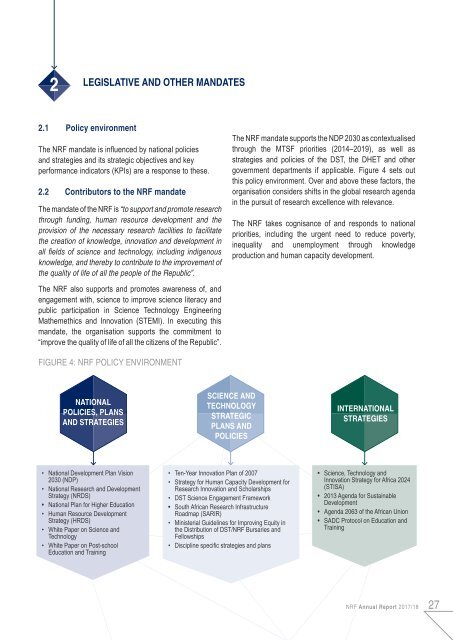NRF Annual Report 2018
You also want an ePaper? Increase the reach of your titles
YUMPU automatically turns print PDFs into web optimized ePapers that Google loves.
PART A: STRATEGIC OVERVIEW<br />
2<br />
LEGISLATIVE AND OTHER MANDATES<br />
2.1 Policy environment<br />
The <strong>NRF</strong> mandate is influenced by national policies<br />
and strategies and its strategic objectives and key<br />
performance indicators (KPIs) are a response to these.<br />
2.2 Contributors to the <strong>NRF</strong> mandate<br />
The mandate of the <strong>NRF</strong> is “to support and promote research<br />
through funding, human resource development and the<br />
provision of the necessary research facilities to facilitate<br />
the creation of knowledge, innovation and development in<br />
all fields of science and technology, including indigenous<br />
knowledge, and thereby to contribute to the improvement of<br />
the quality of life of all the people of the Republic”.<br />
The <strong>NRF</strong> also supports and promotes awareness of, and<br />
engagement with, science to improve science literacy and<br />
public participation in Science Technology Engineering<br />
Mathemethics and Innovation (STEMI). In executing this<br />
mandate, the organisation supports the commitment to<br />
“improve the quality of life of all the citizens of the Republic”.<br />
The <strong>NRF</strong> mandate supports the NDP 2030 as contextualised<br />
through the MTSF priorities (2014–2019), as well as<br />
strategies and policies of the DST, the DHET and other<br />
government departments if applicable. Figure 4 sets out<br />
this policy environment. Over and above these factors, the<br />
organisation considers shifts in the global research agenda<br />
in the pursuit of research excellence with relevance.<br />
The <strong>NRF</strong> takes cognisance of and responds to national<br />
priorities, including the urgent need to reduce poverty,<br />
inequality and unemployment through knowledge<br />
production and human capacity development.<br />
FIGURE 4: <strong>NRF</strong> POLICY ENVIRONMENT<br />
NATIONAL<br />
POLICIES, PLANS<br />
AND STRATEGIES<br />
SCIENCE AND<br />
TECHNOLOGY<br />
STRATEGIC<br />
PLANS AND<br />
POLICIES<br />
INTERNATIONAL<br />
STRATEGIES<br />
• National Development Plan Vision<br />
2030 (NDP)<br />
• National Research and Development<br />
Strategy (NRDS)<br />
• National Plan for Higher Education<br />
• Human Resource Development<br />
Strategy (HRDS)<br />
• White Paper on Science and<br />
Technology<br />
• White Paper on Post-school<br />
Education and Training<br />
• Ten-Year Innovation Plan of 2007<br />
• Strategy for Human Capacity Development for<br />
Research Innovation and Scholarships<br />
• DST Science Engagement Framework<br />
• South African Research Infrastructure<br />
Roadmap (SARIR)<br />
• Ministerial Guidelines for Improving Equity in<br />
the Distribution of DST/<strong>NRF</strong> Bursaries and<br />
Fellowships<br />
• Discipline specific strategies and plans<br />
• Science, Technology and<br />
Innovation Strategy for Africa 2024<br />
(STISA)<br />
• 2013 Agenda for Sustainable<br />
Development<br />
• Agenda 2063 of the African Union<br />
• SADC Protocol on Education and<br />
Training<br />
<strong>NRF</strong> <strong>Annual</strong> <strong>Report</strong> 2017/18 27


